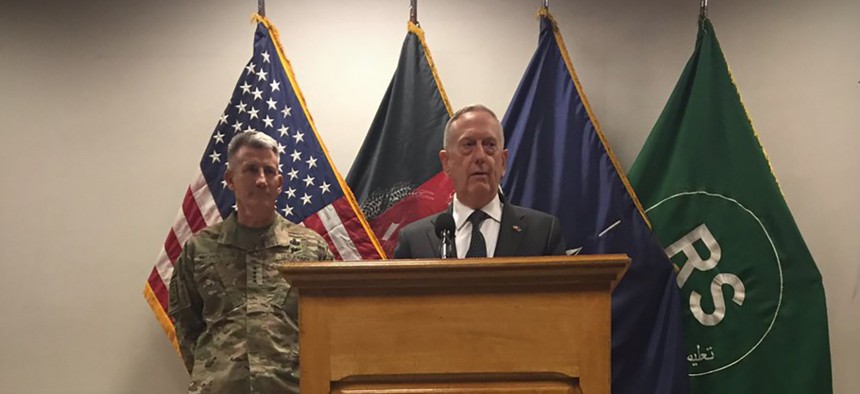
Defense Secretary Jim Mattis speaks to reporters from Resolute Support headquarters in Kabul, Afghanistan, as Gen. John Nicholson stands behind Mattis on April 24, 2017. Photo by Kevin Baron/Defense One
ISIS-in-Afghanistan Is Losing Recruits to Other Groups, US Officials Say
SecDef Mattis says he’s made no decision on adding troops, but warns of a confrontation if Russia continues to arm the Taliban.
KABUL, Afghanistan — The Islamic State branch in Afghanistan, target of the U.S. military’s massive “mother of all bombs” this month, quickly is losing its luster, according to U.S. war commanders here. Thanks to mounting pressure — the U.S.-led coalition claims to have killed hundreds of their fighters in two months — the local branch of the terrorist group that once was so feared in Syria and Iraq is rapidly losing money, support, and recruits.
That’s the good news. The bad news: ISIS is losing those recruits to 19 other extremist organizations in Afghanistan. Those include al-Qaeda, the Taliban, and the Haqqani network, which holds seven Western hostages in Pakistan. And yet ISIS still sits atop the American priority target list because it might be able to strike the U.S. homeland.
That’s the state of the war here, as Defense Secretary Jim Mattis landed Monday for an unannounced visit with commanders and Afghan leaders. President Trump has ordered up a new war plan, and commanders are telling Congress openly they want thousands more American troops to help Afghan forces. But Mattis indicated he is nowhere near a decision on adding more troops of any kind.
“Right now, we are engaged in defining the challenge, the way ahead, with a whole lot of nations and it depends – there is no one nation that’s going to carry all this,” Mattis said, at a press briefing at the international coalition’s headquarters in Kabul. Those nations are assessing the tactical needs, goals, and a desired timeline. “That is exactly why we are meeting now.”
Mattis said he will keep those talks confidential and after returning to Washington he’ll continue to talk to other NATO partners before making his recommendations to them and the president.
Two recent high-profile attacks on an Afghan base and a hospital have cast doubt on the state of security here. The Taliban and ISIS claimed responsibility for both, but a senior U.S. military official in Kabul told reporters that intelligence and history suggest that the more likely perpetrator was the Haqqani network, which the U.S. says continues to receive safe haven and support from Pakistan.
ISIS-K, the Afghan branch, is largely contained to three southern districts of Nangahar province, according to the senior official. More than 100 of its fighters were killed by the April 13 MOAB attack, Afghan officials have said. U.S. officials won’t confirm that figure, largely because the blast site was so damaged that it prevented a body count. But since March, the official said, the U.S.-led coalition force has killed over 500 ISIS fighters,. That leaves just 800 nationwide, including between 450 and 600 in that central district. The number of foreign fighters coming to Afghanistan to join up: zero.
“They have an aspiration to move fighters here from Syria,” said Gen. John “Mick” Nicholson, commanding general here. “We haven’t seen it happen.” Coalition forces already have reduced the group by about two-thirds in size and “reduced their fighters by about half,” he said. “It should be very clear to ISIS main, there is no space in Afghanistan.”
Outside of ISIS, the state of the Afghanistan War remains the same: it is officially considered in a “stalemate,” said the official, echoing the word used by Nicholson and Central Command’s Gen. Joseph Votel in Congress this winter. Afghanistan remains besieged by insurgent and terrorist organizations, all of which have faced a year of increased pressure from Afghan, American, and other NATO and Western forces. Since President Barack Obama loosened restrictions on commanders to go on the offense last spring, more than a half dozen emirs atop targeted groups have been killed, the senior official boasted. Among them was al-Qaeda plotter Faruq al-Qahtani, whom the U.S. claimed had specific plans to target the 2016 U.S. presidential elections, and who was killed last October.
The official said that each “high-value target” kill caused a distinct “90-day to six-month” degradation in each group, disrupting their operations as they sought a new leader. The Taliban in Kunduz province was a loose coalition of not-so-amicable tribes, for example, and since losing its leader, the group has failed to return to the same level of violence, the official said.
Mattis on Russia
Defense Secretary Mattis also warned Russia against arming the Taliban. U.S. officials said they know Russia is increasingly sending more money and weapons to the insurgent opposition over the past year and a half, which Mattis said was illegal.
“We will engage with Russia diplomatically; we will do so where we can, but we’re going to have to confront Russia where what they’re doing is contrary to international law or denying the sovereignty of other countries,” he said. “Any weapons being funneled here through a foreign country would be a violation of internal law, unless they’re coming through the government of Afghanistan for the Afghan forces.”
“We continue to get reports of this assistance,” Nicholson added. Asked if he was not refuting reports Russians were arming the Taliban, the general said, “Oh no, I’m not refuting that.”
The senior U.S. military official who briefed reporters earlier said, “We think it has been increasing over the last 18 months,” based on Russia’s overt statements and U.S. intelligence,
Moscow spins their Taliban support as a hedging a bet: if the Afghanistan security forces can’t handle ISIS and other extremist groups, then at least the Taliban should be able to, the official explained. Yet Russia publicly bases their ISIS worry on claims that the group has thousands of fighters here and more coming from the Middle East, which the U.S. flatly denies.
“We know that’s factually not sure,” said the official.
